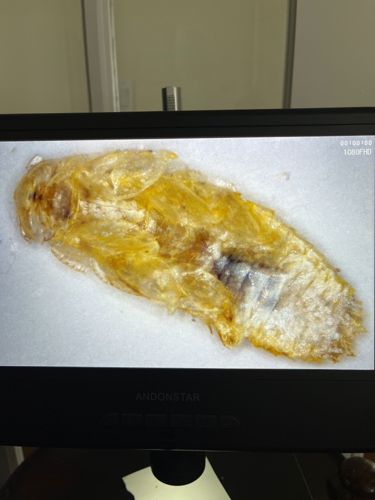Fly Pupa (likely house fly or similar muscoid fly)
Scientific Name: Not determinable to species without further examination. Might be Musca domestica (House Fly) or a related species within Muscidae.
Order & Family: Order: Diptera (True Flies), Family: Muscidae (House Flies and relatives)
Size: Typically 6-12 mm in length for house flies, but can vary depending on the specific species and environmental conditions.

Natural Habitat
Developing pupae are typically found in moist organic material such as decaying matter, garbage, manure, compost piles, or other environments with rotting food or waste. Essentially, anywhere their larvae (maggots) have been feeding.
Diet & Feeding
As pupae, they do not feed. They are an inactive developmental stage. The larval (maggot) stage feeds on decaying organic matter, feces, garbage, and other fermenting substances. Adult flies feed on a variety of liquids, including nectar, decaying matter, and animal secretions.
Behavior Patterns
The pupa is a non-feeding, immobile stage where the larva undergoes metamorphosis into the adult fly. The pupal case, or puparium, is formed from the hardened skin of the last larval instar, and its color can vary from yellowish to dark brown as it matures. The image shows a relatively light-colored puparium, suggesting it might be recently formed or from a species with lighter pigmentation. It's usually found in a dry, secluded place away from the main breeding material of the larvae.
Risks & Benefits
Risks: As a developmental stage of flies, particularly house flies, they are associated with the adult insects that can be vectors for various pathogens, transmitting bacteria, viruses, and parasites that cause diseases like typhoid, cholera, dysentery, salmonellosis, and E. coli. They can also contaminate food. Benefits: Larvae (maggots) play a role in decomposition, breaking down organic waste and recycling nutrients in ecosystems. Some species are reared for animal feed or waste management. The pupal stage itself has no direct risk or benefit to humans, aside from its role in the fly's life cycle.
Identified on: 9/20/2025